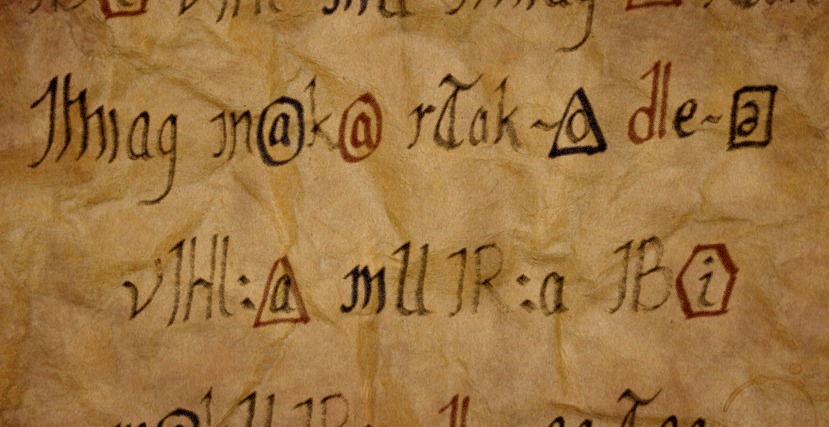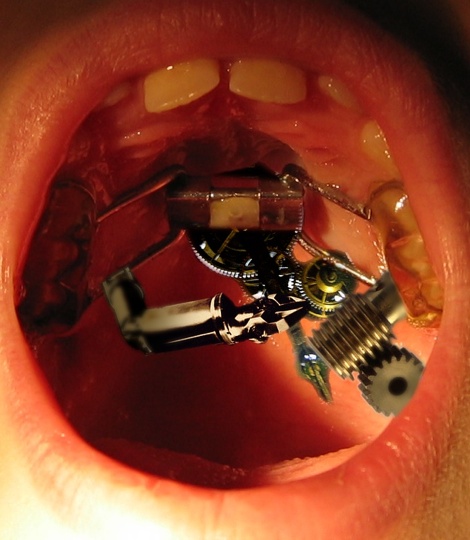


Speculative Grammarian is proud to present yet another irregular installment in the Linguistic Anthropologic Monograph Endowment’s Bizarre Grammars of the World Series.
While the International Space Station continues to lose its luster as a news-
In the late 1790’s, inventor Jeʀ↓emiah Whitney (born Jeremiah, but renamed by his intellectual descendants), a less famous and considerably more eccentric cousin of Eli Whitney, started a small movement among a certain breed of well-
By the 1810’s, the group had grown to between twenty and thirty men, their wives, and their children. In the intervening years, Whitney spent much of his time devising and building artificial speech organs, a project driven by his desire to help his younger brother, Lazlo, who had been, somewhat ironically, disfigured in a cotton gin accident. The fact that Lazlo didn’t want or particularly need his brother’s help did not quench the older Whitney’s desire to create an artificial vocal tract. Since Lazlo was not particularly helpful, Jeʀ↓emiah found ways to install his various test apparatuses in his own mouth. He would leave them in for days at a time, giving him a distinctive speech impediment.
Eventually, many other members of the group decided that Jeʀ↓emiah’s distinctive speech was not an impediment, but rather served as a shibboleth to distinguish between those truly committed to the cause, and those who were mere “spectators and hangers-
By 1827, the group counted among its members one Galilahi, a second cousin of the more famous and somewhat less eccentric Sequoyah, creator of the Cherokee syllabary. Galilahi, perhaps spurred by her cousin’s success, created an early version of an extended Latin alphabet for use by Whitney and his orally-

An early sample of Galilahi’s script (transcribed below). The language is a creolized auxiliary language commissioned by Whitney in 1792 and created by Leon Q. Zamengov, great uncle to the more famous and notably less eccentric inventor of Esperanto, L. L. Zamenhof. There is still much debate among Fɛʀ↓ʁʘʊⓢ↑ scholars as to whether ink color was significant or used primarily for decoration.

In 1864 Keolakupaianaha Worthington, a Winodanugaian refugee ostracized and eventually exiled from her home on an island in the Pacific for her lack of eidetic memory, joined Whitney’s cause. Her perfect pitch and her experience with her native language led to the use of “gear whine” as a communication back-
What followed was a semi-
Over the last two centuries, the group, its goals, their speech, their writing system, and even the spelling of their founder’s name have continued to evolve from their relatively humble technological beginnings.
The name of the clan is an intentional pun, clearly based on English “ferrous”. However, in the Fɛʀ↓ʁʘʊⓢ↑ language is means, quite appropriately, “of machines and men”.
The Fɛʀ↓ʁʘʊⓢ↑ now use a somewhat more computer-
The Fɛʀ↓ʁʘʊⓢ↑ are still vigorously pursuing Whitney’s original goal of merging man and machine. The typical Fɛʀ↓ʁʘʊⓢ↑ undergoes fifteen rounds of technological implantation, with a significant proportion of the implants designed to augment the vocal tract. Pictured here is the interior of the mouth of a six-
The types of articulation available to this six-
According to one on-ship linguist we were able to spend a few minutes with, Fɛʀ↓ʁʘʊⓢ↑ adults have, in addition to the above, the following types of articulation:
Some Orthographic Detail

A sample of Modern Fɛʀ↓ʁʘʊⓢ↑ text, showing the plethora of symbols need by the orthography to represent the mechano-Some Anatomical and Articulatory Detail

The mouth of a typical 6-year-old Fɛʀ↓ʁʘʊⓢ↑ child.
There may be others that the Fɛʀ↓ʁʘʊⓢ↑ are not quite ready to share, and some of these may require additional aural augmentation. (Imagine the possibilities! Parents may be able to communicate in modalities that their children not only cannot understand, but do not yet have the mechanical augmentation required even to perceive!)
As one might imagine, this is a level of phonetic detail that no coursework, textbook, or other academic preparation would leave one ready to deal with. We apologize in advance for the mistakes we have certainly made even in this rudimentary introduction.
Significantly more research is necessary to unravel the complex intricacies of this system. Said research will require more and extremely abundant funding. (A typical travel allowance just isn’t going to cover launch fees!)
0 This paper was made
possible by LAME grant 0100
 |
Resurgent Things You Didn’t Know You Didn’t Know |
 |
I’d Like to Buy a Vowel |
 |
SpecGram Vol CLXV, No 1 Contents |